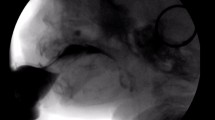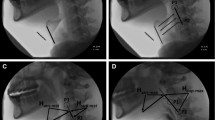Abstract
This investigation assessed the impact of temporal resolution during a videofluoroscopic evaluation of swallowing (VFSS) on measures of duration and kinematics. Thirty adult and ten infant swallow studies, all acquired at 30 frames and 30 pulses per second, were obtained from a New Mexico hospital. All swallow studies were altered to simulate 15 and 5 pulses per second. Duration measures included pharyngeal response time, duration of upper esophageal sphincter (UES) opening, velopharyngeal closure duration and total swallow duration. Kinematic measures were assessed in adults only and included peak hyoid position and extent of UES opening during the swallow. Analysis of outcome measures was performed and compared across the three temporal resolutions (30, 15, and 5 pulses per second). For data points where normative values are available, we evaluated the impact of temporal resolution on clinical determination (i.e., did a change in pulse rate alter the clinical classification). Kinematic and duration measures were altered with changes in pulse rate and these changes increased as temporal resolution decreased. For outcome measures where normative values are available, accuracy of clinical determination decreased with decreased pulse rate. Temporal resolution impacts duration and kinematic measures. However, the direction of these changes is unpredictable, indicating sensitivity and specificity are both affected. Without a predictable impact, the use of lower pulse rates may alter clinical impressions and treatment recommendations yielding inappropriate treatment goals and treatment duration.







Similar content being viewed by others
Data Availability
Raw data are available from the DysphagiaBank which is stored in the TalkBank repository and located at https://aphasia.talkbank.org/access/English/Other/Dysphagia/UNM-access/UNM.html.
References
Steele CM. The blind scientists and the elephant of swallowing: a review of instrumental perspectives on swallowing physiology. J Texture Stud. 2015;46(3):122–37. https://doi.org/10.1111/jtxs.12101.
Martin-Harris B, Canon CL, Bonilha HS, Murray J, Davidson K, Lefton-Greif MA. Best practices in modified barium swallow studies. Am J Speech Lang Pathol. 2020;29(2S):1078–93. https://doi.org/10.1044/2020_AJSLP-19-00189.
Tibbets J, Palmer PM. A survey of New Mexico practice patterns in the evaluation of swallowing disorders. Oral presentation: ASHA Annual Convention, San Diego; 2020. (Convention canceled).
Bonilha HS, Martin-Harris B, O’Rourke AK, Tipnis SV. Radiation exposure in modified barium swallow studies. Curr Opin Otolaryngol Head Neck Surg. 2020;28(6):371–5. https://doi.org/10.1097/MOO.0000000000000665.
Lin EC. Radiation risk from medical imaging. Mayo Clinic Proceedings. 2010;85(12):1142–1146. https://doi.org/10.4065/mcp.2010.0260.
Bonilha HS, Wilmskoetter J, Tipnis S, Horn J, Martin-Harris B, Huda W. Relationships between radiation exposure dose, time, and projection in videofluoroscopic swallowing studies. Am J Speech Lang Pathol. 2019;28(3):1053–9. https://doi.org/10.1044/2019_AJSLP-18-0271.
Cohen MD. Can we use pulsed fluoroscopy to decrease the radiation dose during video fluoroscopic feeding studies in children? Clin Radiol. 2009;64(1):70–3. https://doi.org/10.1016/j.crad.2008.07.011.
Layly J, Marmouset F, Chassagnon G, et al. Can we reduce Frame Rate to 15 images per Second in Pediatric Videofluoroscopic Swallow studies? Dysphagia. 2020;35(2):296–300. https://doi.org/10.1007/s00455-019-10027-8.
Strauss KJ, Kaste SC. The ALARA (as low as reasonably achievable) concept in pediatric interventional and fluoroscopic imaging: striving to keep radiation doses as low as possible during fluoroscopy of pediatric patients—a white paper executive summary. Pediatr Radiol. 2006;36(S2):110. https://doi.org/10.1007/s00247-006-0184-4.
Bonilha HS, Blair J, Carnes B, et al. Preliminary investigation of the effect of pulse rate on judgments of swallowing impairment and treatment recommendations. Dysphagia. 2013;28(4):528–38. https://doi.org/10.1007/s00455-013-9463-z.
Mulheren RW, Azola A, González-Fernández M. Do ratings of swallowing function differ by videofluoroscopic rate? An exploratory analysis in patients after acute stroke. Arch Phys Med Rehabil. 2019;100(6):1085–90. https://doi.org/10.1016/j.apmr.2018.10.015.
Schindelin J, Arganda-Carreras I, Frise E, et al. Fiji: an open-source platform for biological-image analysis. Nat Methods. 2012;9(7):676–82. https://doi.org/10.1038/nmeth.2019.
Steele CM, Peladeau-Pigeon M, Barbon CAE, et al. Reference values for healthy swallowing across the range from thin to extremely thick liquids. J Speech Lang Hear Res. 2019;62(5):1338–63. https://doi.org/10.1044/2019_JSLHR-S-18-0448.
Palmer PM, Padilla AH, MacWhinney B. The development and implementation of a data repository for swallow studies. Dysphagia 2023, 1–8.
Dharmarathna I, Miles A, Fuller L, Allen J. Quantitative video-fluoroscopic analysis of swallowing in infants. Int J Pediatr Otorhinolaryngol. 2020;138:110315. https://doi.org/10.1016/j.ijporl.2020.110315.
Henderson M, Miles A, Holgate V, Peryman S, Allen J. Application and verification of quantitative objective videofluoroscopic swallowing measures in a pediatric population with dysphagia. J Pediatr. 2016;178:200–e2051. https://doi.org/10.1016/j.jpeds.2016.07.050.
Wuensch KL. Nonparametric effect size estimators. https://core.ecu.edu/wuenschk/docs30/Nonparametric-EffectSize.pdf. Published July 19, 2020. Accessed November 1, 2023.
Weckmueller J, Easterling C, Arvedson J. Preliminary temporal measurement analysis of normal oropharyngeal swallowing in infants and young children. Dysphagia. 2011;26(2):135–43. https://doi.org/10.1007/s00455-010-9283-3.
Rosenbek JC, Robbins JA, Roecker EB, Coyle JL, Wood JL. A penetration-aspiration scale. Dysphagia. 1996;11(2):93–8. https://doi.org/10.1007/bf00417897.
Palmer PM, Padilla AH. Risk of an adverse event in individuals who aspirate: a review of current literature on host defenses and individual differences. Am J Speech Lang Pathol. 2022;31(1):148–62. https://doi.org/10.1044/2021_AJSLP-20-00375.
Acknowledgements
The authors wish to acknowledge TIMS for their donation of viewing software and to all the individuals whose assessments were used in this project, Brian MacWhinney PhD and the team at TalkBank for allowing us to develop and store a repository database to support research like this, Philip Dale PhD for his advice throughout this project, Camella Rosenberg for her statistics consults, and to the students in the UNM Swallow Disorders Research Lab for their guidance, time, and assistance throughout this endeavor.
Funding
This study was not funded.
Author information
Authors and Affiliations
Contributions
All authors contributed to the study conception and design. All authors contributed to data collection and analysis. The first draft of the manuscript was written by [Phyllis Palmer] and all authors commented on previous versions of the manuscript. All authors read and approved the final manuscript.
Corresponding author
Ethics declarations
Ethical Approval
No animals were used in this study. Human data involved retrospective data that was collected for clinical purposes. All procedures performed in this study were in accordance with the ethical standards of the institutional and/or national research committee and with the 1964 Helsinki declaration and its later amendments or comparable ethical standards. Informed consent was waived.
Conflict of Interest
Author A declares that she has no conflicts. Author B declared that he has no conflicts. Author C declares that she has no conflicts. Author D declares that she has no conflicts. Author E declares that she has no conflicts. Author F declares that she has no conflicts.
Additional information
Publisher’s Note
Springer Nature remains neutral with regard to jurisdictional claims in published maps and institutional affiliations.
Electronic Supplementary Material
Below is the link to the electronic supplementary material.
Rights and permissions
Springer Nature or its licensor (e.g. a society or other partner) holds exclusive rights to this article under a publishing agreement with the author(s) or other rightsholder(s); author self-archiving of the accepted manuscript version of this article is solely governed by the terms of such publishing agreement and applicable law.
About this article
Cite this article
Palmer, P.M., Padilla, A.H., Murray, S.C. et al. The Impact of Videofluoroscopic Pulse Rate on Duration and Kinematic Measures in Infants and Adults with Feeding and Swallowing Disorders. Dysphagia (2024). https://doi.org/10.1007/s00455-024-10709-y
Received:
Accepted:
Published:
DOI: https://doi.org/10.1007/s00455-024-10709-y




